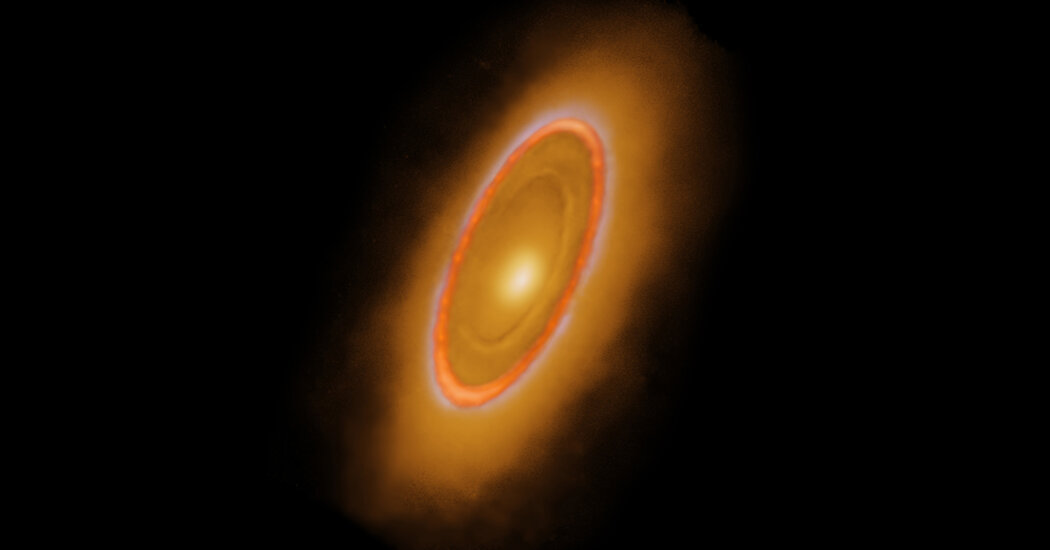Fomalhaut, a star just 25 light-years away, is so dazzlingly bright that it blots out the faint light of other stars around it. Stargazers have been enraptured by its secrets for thousands of years.
Now, with the help of the James Webb Space Telescope, astronomers have documented evidence that Fomalhaut is a dynamic star wreathed in cosmic chaos. The powerful observatory’s infrared vision is letting astronomers better understand Fomalhaut’s features, including a mysterious ring unlike anything found in our solar system.
“It’s complex — there’s so much going on!” said Andras Gaspar, an astronomer at the University of Arizona and one of the authors of a study using the Webb observations that was published Monday in Nature Astronomy. “It’s the first time we’ve seen such structures in an evolved system.”
The findings could contribute to the solution to an existential puzzle: How weird, or ordinary, is our solar system? “It’s hard to draw conclusions about if we’re common or not, if our specific configuration is everywhere or nowhere,” said Jessie Christiansen, the project scientist at NASA’s Exoplanet Archive, who was not involved with the new study.
Fomalhaut dwells in the southern constellation Piscis Austrinus. The star is 440 million years old — young compared with our 4.6-billion-year-old sun. But Fomalhaut is a type of star that lives no more than a billion years. That means that, much like the sun, it is halfway through its expected stellar life.
Fortunately for the living things in our solar system, the sun shows no signs of a midlife crisis. Aside from the occasional asteroid or comet impact, most larger objects stick to their orbital lanes. Much of the cloud of debris that cloaks younger stars congealed eons ago into the eight discrete planets, with the main remaining fields of cosmic wreckage being the rocky asteroid belt between Mars and Jupiter and the icy Kuiper belt beyond Neptune.
Fomalhaut offers a more reckless take on middle age, and a contrast with our orderly planetary system. But it was only recently that technology caught up with astronomical ambitions to understand the star’s scattered surroundings.
For the new study, Dr. Gaspar and his team pointed Webb’s Mid-Infrared Instrument at Fomalhaut. Unlike earlier space and ground telescopes, Webb can detect the faintest infrared glows emitted by dusty debris — and it revealed not one, but three nested rings of ruin around Fomalhaut. The inner ring is analogous to our asteroid belt, while the outer ring is comparable to the sun’s Kuiper belt. But Fomalhaut also has an intermediate debris highway between the two, most likely a mix of icy and rocky ephemera. The solar system lacks this superstructure, “in part because we’ve got these big honking planets in the middle” — Jupiter, Saturn, Uranus and Neptune — “that cleared stuff out,” said Bruce Macintosh, the director of the University of California Observatories, who was not involved with the study. The gap between Fomalhaut’s inner and intermediate rings may have been carved out by a planet. But no direct evidence of any worlds could be seen. By this point in Fomalhaut’s life cycle, most planets would have cooled off, and only one many times the size of Jupiter would still be hot enough to be detected by the Webb’s infrared instrument. “You could hide Jupiters in there, all over the place, and nobody would know,” Dr. Macintosh said. The intermediate belt is also where exoplanet hunters once thought they had seen a world they named Fomalhaut b. But in 2020, Dr. Gaspar and his colleagues proposed that what other scientists had once thought was an intact exoplanet was actually an expanding cloud of debris created by an epic collision. A problem with this idea was that this part of space looked vacant, so it seemed unlikely that two objects had managed to crash into each other. The team’s discovery of the intermediate debris belt has now proffered a solution. “We now know there’s stuff there,” Dr. Christiansen of the NASA archive said. “OK, so it’s a collision — we can finally put that to bed.” Cataclysmic melees are not just transpiring close to the star. What looks like a vast maelstrom of dust within the outer belt may be the ghost of another gargantuan impact. “That’s just cool,” Dr. Christensen said. “What is it? It’s very tantalizing.” Astronomers are thrilled that the Webb telescope offers a front-row seat to this star’s drama. It also makes them appreciate the comparatively tranquil nature of the solar system. Fomalhaut would be “chaotic as hell,” Dr. Macintosh said, adding, “If there are planets there, they’re getting smacked around by asteroids all the time.” Source: Read Full Article





